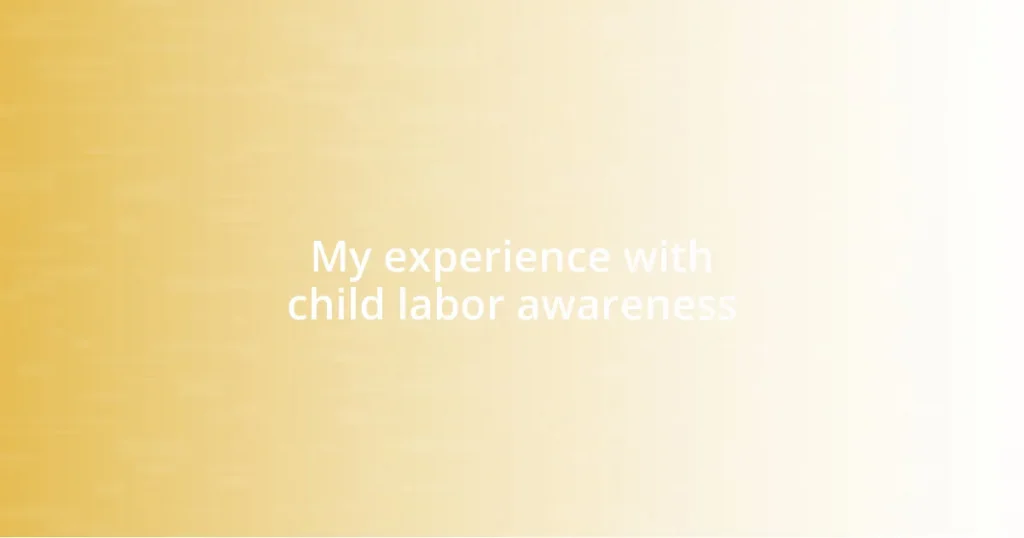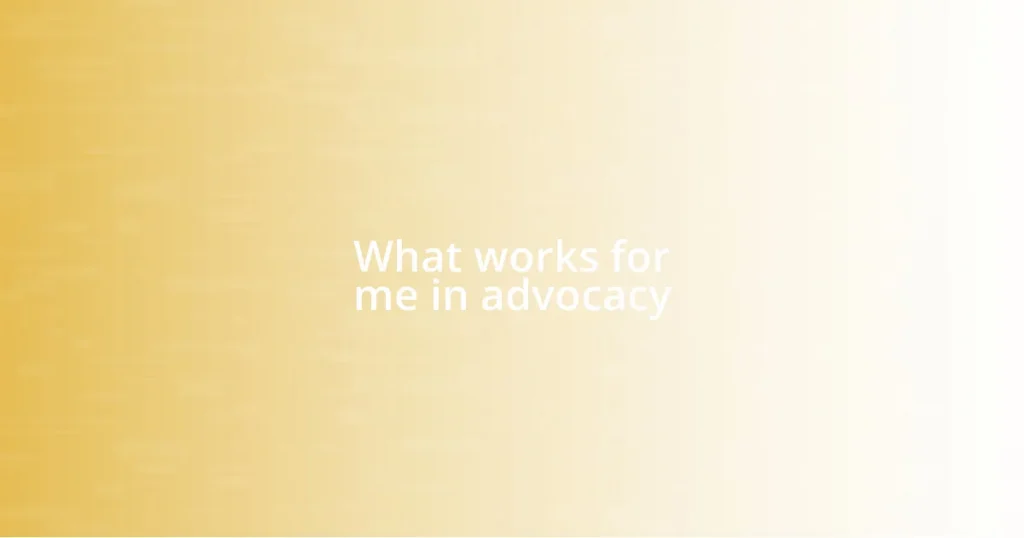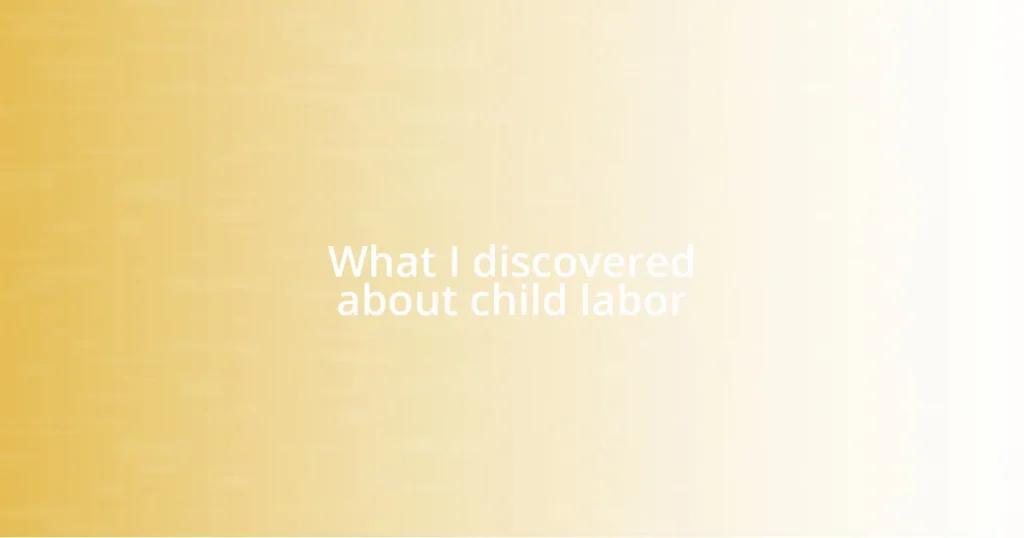Key takeaways:
- Child labor affects over 160 million children globally, driven by poverty, lack of education, and cultural practices.
- Personal experiences, like meeting children in labor, can ignite advocacy and awareness efforts in communities.
- There is a critical need for educational access to empower children and break the cycle of poverty.
- Collaborative community initiatives and partnerships with local businesses are essential for effective awareness and support against child labor.

Understanding child labor issues
Child labor is a pervasive issue that affects millions of children worldwide, often forcing them into dire working conditions that rob them of their childhood. I remember visiting a small village where children as young as six were laboring long hours in fields, their faces marked with exhaustion. That sight made me wonder, how can we allow such a precious stage of life to be overshadowed by hardship?
The reasons behind child labor are complex and often rooted in poverty, lack of education, and cultural practices. During my travels, I encountered parents who believed that their children needed to contribute to the family income, often sacrificing their education. I couldn’t help but feel heartbroken. Why should the future of these children be compromised for immediate survival?
Additionally, the impact of child labor extends beyond the individual child. It perpetuates a cycle of poverty, affecting families and communities for generations. I often reflect on how many potential leaders, innovators, and change-makers may be lost to this cycle. If we don’t act, what kind of world are we creating for the next generation?

My personal journey
My journey into child labor awareness began unexpectedly during a volunteering trip in a rural community. As I helped organize a small educational workshop, I met a boy named Ravi, who was my age yet was already working in a textile factory. It struck me how different our paths were, and that realization ignited a passion within me to advocate for change. The disparity between our lives felt like a heavy weight in my heart.
- A chance encounter with Ravi shifted my perspective on childhood.
- I learned that education can be a lost dream for many kids.
- Each story I encountered fueled my commitment to be an advocate.
Another impactful moment was when I attended a local event focused on child labor rights. Listening to parents share their struggles, I felt an overwhelming sense of urgency to raise awareness. I realized that education is not just about classrooms; it’s about empowering families and communities. Every voice matters in this fight, and I committed myself to be that voice.

Key statistics on child labor
Key statistics on child labor highlight the magnitude of this issue, revealing the harsh realities faced by millions of children globally. For instance, it’s estimated that over 160 million children are engaged in child labor, representing nearly 1 in 10 children worldwide. The fact that such a significant number is forced into labor instead of attending school truly pains me. I often think about the dreams these children might have if given the opportunity to learn and grow.
Diving deeper, the statistics illuminate the stark differences in child labor prevalence across regions. In sub-Saharan Africa, for example, approximately 1 in 5 children are engaged in labor, compared to just 1 in 25 in Europe and North America. This disparity emphasizes not only the urgent need for action in certain regions but also reminds me of the privilege of education that many of us take for granted. Each number represents a life, a story, and it drives home the significance of our collective responsibility to enact change.
To further underscore these disturbing trends, the global child labor rate has seen minimal decline over the past decade. Recent reports suggest that the pandemic exacerbated this issue, pushing an additional 9 million children into child labor since 2020. It makes me wonder how many children are now missing out on the simple joys of childhood—playing, learning, dreaming. The statistics are more than just numbers; they reflect a crisis that demands our attention and action.
| Statistic | Value |
|---|---|
| Total number of child laborers | Over 160 million |
| Child labor prevalence in sub-Saharan Africa | 1 in 5 children |
| Child labor prevalence in Europe and North America | 1 in 25 children |
| Increase in child laborers due to the pandemic | 9 million children |

Organizations fighting child labor
There are several remarkable organizations dedicated to fighting child labor, each making significant strides in raising awareness and providing solutions. For example, I was particularly inspired by the work of Save the Children. Their programs focus not just on rescuing children from labor but also on providing educational opportunities that break the cycle of poverty. Isn’t it amazing how education can serve as a powerful tool for liberation?
Another impactful organization is The International Labour Organization (ILO), which plays a crucial role in setting global standards and policies to combat child labor. I remember reading about their global campaign, “End Child Labor,” which seeks to mobilize communities and engage governments to take action. The thought of united efforts across nations gives me hope; could you imagine a world where every child receives the protection and education they deserve?
Lastly, I’ve come across local grassroots organizations that work tirelessly within their communities to create awareness. One such initiative I volunteered with focused on providing resources for families, helping them to understand the value of education over labor. Seeing parents gain confidence in advocating for their children’s rights was profoundly moving. It’s a reminder that change often begins at the community level—what if we all took that approach?

How to raise awareness
Raising awareness about child labor takes more than just sharing statistics. I remember when I first organized a local awareness campaign in my community, complete with informational booths and discussions. The energy was palpable as we engaged people in conversations about the realities of child labor, and it dawned on me how sharing personal stories made the topic resonate on a much deeper level. Have you ever witnessed the power of a story to change someone’s perception?
Social media is another vital tool for spreading awareness. During one of my online campaigns, I created shareable graphics that highlighted shocking facts about child labor. The immediate feedback was encouraging—friends were reposting, tagging their networks, and sparking conversations. In that moment, I realized how easily we can harness the power of our social circles. I keep wondering, what would happen if every individual made it their mission to spread the word in their own networks?
Lastly, collaborating with schools can amplify awareness efforts significantly. In a project I participated in, we held workshops at local schools that encouraged students to think critically about global issues. Seeing young minds engage with such a serious topic was inspiring. It made me believe that educating the next generation about child labor can instill a sense of responsibility in them. How can we ensure that these valuable lessons continue beyond the classroom?

Ways to support affected children
Supporting affected children requires a multifaceted approach that combines immediate relief with long-term solutions. For instance, I remember volunteering at a local shelter that provided meals and counseling to children rescued from labor. Witnessing their expressions of relief and gratitude reinforced my belief in the importance of creating safe spaces where children can begin to heal. How transformative can a simple meal and a listening ear be for kids who have suffered so much?
Another effective way to support these children is by advocating for educational access. I once met a young girl whose life changed drastically when she received a scholarship to attend school. The sparkle in her eyes as she talked about her dreams made me realize how crucial education is to breaking the cycle of poverty. By supporting initiatives that provide educational resources, we can empower these children to build a better future for themselves. Isn’t it powerful to think that one child’s success can inspire an entire community?
Lastly, it’s essential to engage families and communities in the dialogue about the importance of child labor prevention. I recall a community event where we discussed the impact of child labor on families. The conversations were heartfelt, and parents were eager to take steps to prioritize their children’s education over work. This experience taught me that equipping families with knowledge and resources can create a ripple effect of change. How can we ensure that this conversation continues beyond one event?

Planning a community initiative
Planning a community initiative requires careful thought and collaboration. I remember when we first gathered a small group of passionate individuals to brainstorm ideas for raising awareness about child labor. The excitement in the room was contagious as we shared our personal connections to the issue, and it became clear that each voice mattered. Did you ever notice how a diverse group can enhance creativity and bring fresh perspectives?
As we mapped out our strategy, one approach that stood out was forming partnerships with local businesses. I reached out to a nearby coffee shop, and to my surprise, they were eager to host our informational sessions. It felt amazing to see a local establishment willing to support our cause—this highlighted how much community members want to engage with critical issues. Have you ever wondered how local support can shape the success of a campaign?
Next, we emphasized the importance of setting clear goals and measurable outcomes. At our planning meeting, we discussed our vision: to educate at least 200 people within three months. By the end of that period, not only did we meet our target, but we also sparked ongoing conversations beyond our initial campaign. This experience taught me that if we lay a solid foundation, the ripples of our efforts can extend surprising distances. What hesitant possibilities can be transformed into tangible realities with thoughtful planning?















